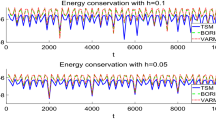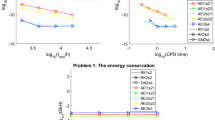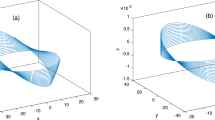Abstract
This paper is devoted to the numerical symplectic approximation of the charged-particle dynamics (CPD) with a homogeneous magnetic field and its extension to a non-homogeneous magnetic field. By utilizing continuous-stage methods and exponential integrators, a general class of symplectic methods is formulated for CPD under a homogeneous magnetic field. Based on the derived symplectic conditions, two practical symplectic methods up to order four are constructed where the error estimates show that the proposed second order scheme has a uniform accuracy in the position w.r.t. the strength of the magnetic field. Moreover, the symplectic methods are extended to CPD under a non-homogeneous magnetic field and three algorithms are formulated. Rigorous error estimates are investigated for the proposed methods and one method is proved to have a uniform accuracy in the position w.r.t. the strength of the magnetic field. Numerical experiments are provided for CPD under homogeneous and non-homogeneous magnetic fields, and the numerical results support the theoretical analysis and demonstrate the remarkable numerical behavior of our methods.
Similar content being viewed by others
References
Arnold, V.I., Kozlov, V.V., Neishtadt. A.I.: Mathematical aspects of classical and celestial mechanics. Springer, Berlin (1997)
Bao, W., Su, C.: A uniformly and optimally accurate methods for the Zakharov system in the subsonic limit regime. SIAM J. Sci. Comput. 40, A929–A953 (2018)
Bao, W., Zhao, Q.: A structure-preserving parametric finite element method for surface diffusion. SIAM J. Numer. Anal. 59, 2775–2799 (2021)
Benettin, G., Sempio, P.: Adiabatic invariants and trapping of a point charge in a strong nonuniform magnetic field. Nonlinearity 7, 281–304 (1994)
Blanes, S., Iserles, A.: Explicit adaptive symplectic integrators for solving Hamiltonian systems. Celest. Mech. Dyn. Astron. 114, 297–317 (2012)
Blanes, S., Iserles, A., MacNamara, S.: Positivity-preserving methods for ordinary differential equations. ESAIM Math. Model. Number. Anal. 56, 1843–1870 (2022)
Boris, J.P.: Relativistic plasma simulation-optimization of a hybird code. In: Proceeding of fourth conference on numerical simulations of plasmas, pp. 3-67 (1970)
Brizard, A.J., Hahm, T.S.: Foundations of nonlinear gyrokinetic theory. Rev. Modern Phys. 79, 421–468 (2007)
Brugnano, L., Iavernaro, F., Zhang, R.: Arbitrarily high-order energy-preserving methods for simulating the gyrocenter dynamics of charged particles. J. Comput. Appl. Math. 380, 112994 (2020)
Brugnano, L., Montijano, J.I., Rándz, L.: High-order energy-conserving line integral methods for charged particle dynamics. J. Comput. Phys. 396, 209–227 (2019)
Cary, J.R., Brizard, A.J.: Hamiltonian theory of guiding-center motion. Rev. Modern Phys. 81, 693–738 (2009)
Chartier, Ph., Crouseilles, N., Lemou, M., Méhats, F., Zhao, X.: Uniformly accurate methods for Vlasov equations with non-homogeneous strong magnetic field. Math. Comp. 88, 2697–2736 (2019)
Chartier, Ph., Crouseilles, N., Lemou, M., Méhats, F.: Zhao, X.: Uniformly accurate methods for three dimensional Vlasov equations under strong magnetic field with varying direction. SIAM J. Sci. Comput. 42, B520-B547 (2020)
Feng, K.: On difference schemes and symplectic geometry. In: Proceedings of the 1984 Beijing Symposium on diferential geometry and differential equations, (Edited by K. Feng), pp. 42-58. Science Press, Beijing (1985)
Filbet, F., Rodrigues, M.: Asymptotically stable particle-in-cell methods for the Vlasov-Poisson system with a strong external magnetic field. SIAM J. Numer. Anal. 54, 1120–1146 (2016)
Filbet, F., Rodrigues, M.: Asymptotically preserving particle-in-cell methods for inhomogeneous strongly magnetized plasmas. SIAM J. Numer. Anal. 55, 2416–2443 (2017)
Filbet, F., Xiong, T., Sonnendrücker, E.: On the Vlasov-Maxwell system with a strong magnetic field. SIAM J. Appl. Math. 78, 1030–1055 (2018)
Frénod, E., Hirstoaga, S.A., Lutz, M., Sonnendrücker, E.: Long time behavior of an exponential integrator for a Vlasov-Possion system with strong magnetic field. Commun. Comput. Phys. 18, 263–296 (2015)
Hairer, E.: Energy-preserving variant of collocation methods. JNAIAM J. Numer. Anal. Ind. Appl. Math. 5, 73-84 (2010)
Hairer, E., Lubich, Ch.: Long-term analysis of a variational integrator for charged-particle dynamics in a strong magnetic field. Numer. Math. 144, 699–728 (2020)
Hairer, E., Lubich, Ch.: Energy behaviour of the Boris method for charged-particle dynamics. BIT 58, 969–979 (2018)
Hairer, E., Lubich, Ch.: Symmetric multistep methods for charged-particle dynamics. SMAI J. Comput. Math. 3, 205–218 (2017)
Hairer, E., Lubich, Ch., Shi, Y.: Large-stepsize integrators for charged-particle dynamics over multiple time scales. Numer. Math. 151, 659–691 (2022)
Hairer, E., Lubich, Ch., Wanner, G.: Geometric numerical integration: structure-preserving algorithms for ordinary differential equations, 2nd edn. Springer-Verlag, Berlin, Heidelberg (2006)
Hairer, E., Lubich, Ch., Wang, B.: A filtered Boris algorithm for charged-particle dynamics in a strong magnetic field. Numer. Math. 144, 787–809 (2020)
He, Y., Sun, Y., Liu, J., Qin, H.: Volume-preserving algorithms for charged particle dynamics. J. Comput. Phys. 281, 135–147 (2015)
He, Y., Zhou, Z., Sun, Y., Liu, J., Qin, H.: Explicit K-symplectic algorithms for charged particle dynamics. Phys. Lett. A 381, 568–573 (2017)
Hochbruck, M., Ostermann, A.: Exponential integrators. Acta Numer. 19, 209–286 (2010)
Hochbruck, M., Ostermann, A.: Explicit exponential Runge-Kutta methods for semilineal parabolic problems. SIAM J. Numer. Anal. 43, 1069–1090 (2005)
Knapp, L., Kendl, A., Koskela, A., Ostermann, A.: Splitting methods for time integration of trajectories in combined electric and magnetic fields. Phys. Rev. E 92, 063310 (2015)
Li, T., Wang, B.: Geometric continuous-stage exponential energy-preserving integrators for charged-particle dynamics in a magnetic field from normal to strong regimes. Appl. Numer. Math. 181, 1–22 (2022)
Mei, L., Wu, X.: Symplectic exponential Runge-Kutta methods for solving nonlinear Hamiltonian systems. J. Comput. Phys. 338, 567–584 (2017)
Miyatake, Y., Butcher, J.C.: Characterization of energy-preserving methods and the construction of parallel integrators for Hamiltonian systems. SIAM J. Numer. Anal. 54, 1993–2013 (2016)
Northrop, T.G.: The adiabatic motion of charged particles. In: Interscience Tracts on Physics and Astronomy, Vol. 21, Interscience Publishers, John Wiley and Sons, New York, London, Sydney, (1963)
Possanner, S.: Gyrokinetics from variational averaging: existence and error bounds. J. Math. Phys. 59, 082702 (2018)
Qin, H., Zhang, S., Xiao, J., Liu, J., Sun, Y., Tang, W.: Why is Boris algorithm so good? Phys. Plasmas 20, 084503 (2013)
Ricketson, L.F., Chacón, L.: An energy-conserving and asymptotic-preserving charged-particle orbit implicit time integrator for arbitrary electromagnetic fields. J. Comput. Phys. 418, 109639 (2020)
Sanz-Serna, J.M.: Rutta-Kutta schemes for Hamiltonian systems. BIT 28, 877–883 (1988)
Sanz-Serna, J.M., Abia, L.: Order conditions for canonical Runge-Kutta schemes. SIAM J. Numer. Anal. 28, 1081–1096 (1991)
Shi, Y., Sun, Y., Wang, Y., Liu, J.: Study of adaptive symplectic methods for simulating charged particle dynamics. J. Comput. Dyna. 6, 429–448 (2019)
Suris, Y.B.: The canonicity of mapping generated by Runge-Kutta type methods when integrating the systems \(\ddot{x}=-\frac{\partial U}{\partial x}\). Zh. Vychisl. Mat. Mat. Fiz. 29, 202-211 (1989)(in Russian); same as USSR Comput. Math. Phys. 29, 138-144 (1989)
Tang, W., Zhang, J.: Symplecticity-preserving continuous-stage Runge-Kutta-Nyström methods. Appl. Math. Comput. 323, 204–219 (2018)
Tao, M.: Explicit high-order symplectic integrators for charged particles in general electromagnetic fields. J. Comput. Phys. 327, 245–251 (2016)
Wang, B., Iserles, A., Wu, X.: Arbitrary-order trigonometric Fourier collocation methods for multi-frequency oscillatory systems. Found. Comput. Math. 16, 151–181 (2016)
Wang, B., Wu, X., Fang, Y.: A two-step symmetric method for charged-particle dynamics in a normal or strong magnetic field. Calcolo 57, 29 (2020)
Wang, B., Zhao, X.: Error estimates of some splitting schemes for charged-particle dynamics under strong magnetic field. SIAM J. Numer. Anal. 59, 2075–2105 (2021)
Wang, B., Zhao, X.: Geometric two-scale integrators for highly oscillatory system: uniform accuracy and near conservations. SIAM J. Numer. Anal. 61, 1246–1277 (2023)
Webb, S.D.: Symplectic integration of magnetic systems. J. Comput. Phys. 270, 570–576 (2014)
Xiao, J., Qin, H.: Explicit high-order gauge-independent symplectic algorithms for relativistic charged particle dynamics. Comput. Phys. Commun. 241, 19–27 (2009)
Xiao, J., Qin, H.: Slow manifolds of classical Pauli particle enable structure-preserving geometric algorithms for guiding center dynamics. Comput. Phys. Commun. 265, 107981 (2021)
Zhang, R., Qin, H., Tang, Y., Liu, J., He, Y., Xiao, J.: Explicit symplectic algorithms based on generating functions for charged particle dynamics. Phys. Revi. E 94, 013205 (2016)
Acknowledgements
The authors sincerely thank the two anonymous reviewers for the very valuable comments and helpful suggestions. This work was supported by NSFC (12371403) and Fundamental Research Funds for the Central Universities (xzy022022014).
Author information
Authors and Affiliations
Corresponding author
Ethics declarations
Conflicts of interest
The authors declare that they have no known competing financial interests or personal relationships that could have appeared to influence the work reported in this paper.
Additional information
Communicated by: Aihui Zhou
Publisher's Note
Springer Nature remains neutral with regard to jurisdictional claims in published maps and institutional affiliations.
Appendix
Appendix
Firstly, consider a Taylor expansion of the function \( \vartheta (\nu )\) at the origin with real coefficients \(c_{n}\), and formulate \(\vartheta (iy)\) as the following form
where \(\vartheta _{1}(y)=\sum \limits _{j \ge 0} c_{2j+1}(-y^2)^{j}\) and \(\vartheta _{2}(y)=\sum \limits _{j \ge 0} c_{2j+2}(-y^2)^{j}\).
Then for a vector \(B=\big (B_1,B_2,B_3\big )^{\intercal }\) and a skew symmetric matrix \(M=\frac{1}{\epsilon }\left( \begin{array}{ccc} 0 &{} B_3 &{} -B_2 \\ -B_3 &{} 0 &{} B_1 \\ B_2 &{} -B_1 &{} 0 \\ \end{array} \right) \), it can be checked that \(M^3=-m^2 M\) with \(m= \frac{\Vert B\Vert }{\epsilon }\). Based on (5.1), one obtains that
which leads to the calculation of \(\vartheta (M) v\) by estimating the scalars \(\vartheta (0)\), \(\vartheta _{1}(m)\), \(\vartheta _{2}(m)\), and by forming twice a product of M with a vector.
Finally, we present the computation of \(\varphi _{0}\) and \( \varphi _{1}\) via the above results. Before going further, it is noted that \(\vartheta _{1}(y)=0\) if \( \vartheta (\nu )\) has only even powers of \(\nu \) and \(\vartheta (0)=0,\ \vartheta _{2}(y)=0\) if there are only odd powers of \(\nu \). Now we are in a position to get
The expressions of the coefficients \(\alpha _{\tau \sigma }(hM)\), \(\beta _{\tau }( hM )\) and \(\gamma _{\tau }( hM )\) can be derived similarly. Moreover, from the above analysis, it follows that \(\bar{\varphi }(W)=\varphi (\bar{W}),\) where \(W=h\tilde{\Lambda }\textrm{i}\) with \(\tilde{\Lambda }=diag (-m,0,m)\).
Rights and permissions
Springer Nature or its licensor (e.g. a society or other partner) holds exclusive rights to this article under a publishing agreement with the author(s) or other rightsholder(s); author self-archiving of the accepted manuscript version of this article is solely governed by the terms of such publishing agreement and applicable law.
About this article
Cite this article
Li, T., Wang, B. Continuous-stage adapted exponential methods for charged-particle dynamics with arbitrary magnetic fields. Adv Comput Math 49, 89 (2023). https://doi.org/10.1007/s10444-023-10093-5
Received:
Accepted:
Published:
DOI: https://doi.org/10.1007/s10444-023-10093-5
Keywords
- Charged particle dynamics
- Symplectic methods
- Uniform error bounds
- Exponential methods
- Continuous-stage methods




